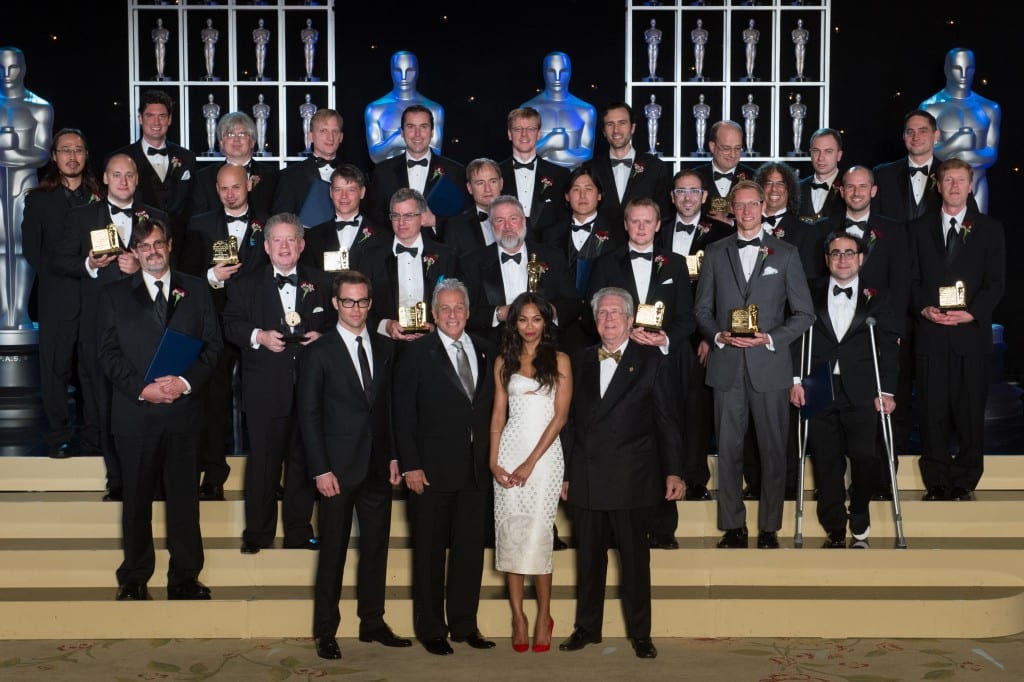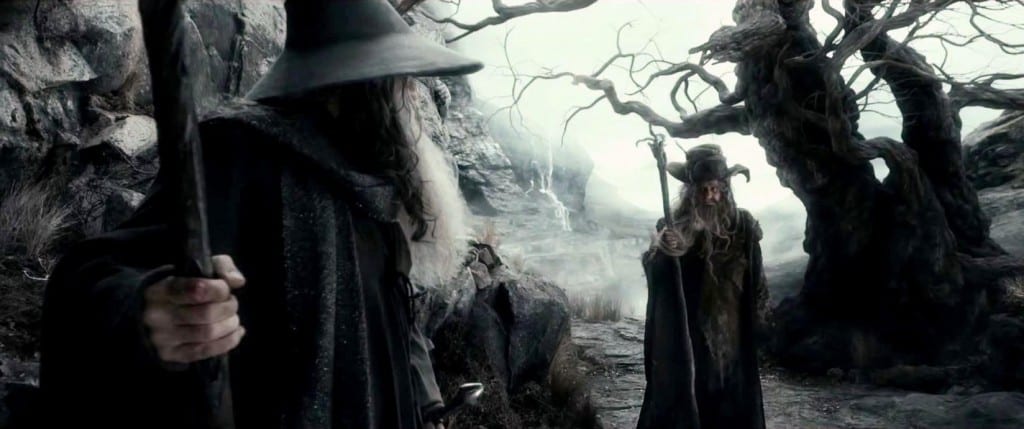
Image via: onlyoscar.files.wordpress.com
Here are the winners of the 2013 Science and Technical Awards.
Gordon E. Sawyer Award
Visual effects supervisor and director of photography Peter W. Anderson, ASC has been voted the Gordon E. Sawyer Award by the Board of Governors, for technological contributions that have brought credit to the industry.
John A. Bonner Medal of Commendation
Post-production and distribution executive Charles “Tad” Marburg has been voted the John A. Bonner Medal of Commendation by the Board of Governors, for outstanding service and dedication in upholding the high standards of the Academy.
Technical Achievement Award (Academy Certificate)
To Olivier Maury, Ian Sachs and Dan Piponi for the creation of the ILM Plume system that simulates and renders fire, smoke and explosions for motion picture visual effects The unique construction of this system combines fluid solving and final image rendering on the GPU (Graphics Processing Unit) hardware without needing an intermediate step involving the CPU. This innovation reduces turnaround time, resulting in significant efficiency gains for the ILM effects department.
To Ronald D. Henderson for the development of the FLUX gas simulation system. The use of the Fast Fourier Transform for solving partial differential equations allows FLUX a greater level of algorithmic efficiency when multi-threading on modern hardware. This innovation enables the creation of very high-resolution fluid effects while maintaining fast turnaround times.
To Andrew Camenisch, David Cardwell and Tibor Madjar for the concept and design, and to Csaba Kohegyi and Imre Major for the implementation of the Mudbox software. Mudbox provides artists powerful new design capabilities that significantly advance the state of the art in multi-resolution digital sculpting for film production.
To Martin Hill, Jon Allitt and Nick McKenzie for the creation of the spherical harmonics-based efficient lighting system at Weta Digital. The spherical harmonics lighting pipeline precomputes and reuses a smooth approximation of time-consuming visibility calculations. This enables artists to quickly see the results of changing lights, materials and set layouts in scenes with extremely complex geometry.
To Florian Kainz, Jeffery Yost, Philip Hubbard and Jim Hourihan for the architecture and development of the Zeno application framework. For more than a decade, Zeno’s flexible and robust design has allowed the creation of a broad range of Academy Award-winning visual effects toolsets at ILM.
To Peter Huang and Chris Perry for their architectural contributions to, and to Hans Rijpkema and Joe Mancewicz for the core engineering of, the Voodoo application framework. For more than a decade, Voodoo’s unique design concepts have enabled a broad range of character animation toolsets to be developed at Rhythm & Hues.
To Matt Pharr, Greg Humphreys and Pat Hanrahan for their formalization and reference implementation of the concepts behind physically based rendering, as shared in their book Physically Based Rendering. Physically based rendering has transformed computer graphics lighting by more accurately simulating materials and lights, allowing digital artists to focus on cinematography rather than the intricacies of rendering. First published in 2004,Physically Based Rendering is both a textbook and a complete source-code implementation that has provided a widely adopted practical roadmap for most physically based shading and lighting systems used in film production.
To Dr. Peter Hillman for the long-term development and continued advancement of innovative, robust and complete toolsets for deep compositing. Dr. Hillman’s ongoing contributions to standardized techniques and a common deep image file format have enabled advanced compositing workflows across the digital filmmaking industry.
To Colin Doncaster, Johannes Saam, Areito Echevarria, Janne Kontkanen and Chris Cooper for the development, prototyping and promotion of technologies and workflows for deep compositing. Their contributions include early advancements in key deep compositing features such as layer and holdout-order independence, spatial and intra-element color correction, post-render depth of field, and precise blending of complex layer edges.
To Thomas Lokovic and Eric Veach for their influential research and publication of the fundamental concepts of deep shadowing technology. Providing a functional and efficient model for the storage of deep opacity information, this technology was widely adopted as the foundation of early deep compositing pipelines.
To Gifford Hooper and Philip George of HoverCam for the continuing development of the Helicam miniature helicopter camera system. The current Helicam system is a high-speed, extremely maneuverable, turbine-engine, radio-controlled miniature helicopter that supports professional film and digital cinema cameras. Helicam provides a wide range of stabilized, remotely operated pan, tilt and roll capabilities, achieving shots impossible for full-size helicopters.
To John Frazier, Chuck Gaspar and Clay Pinney for the design and development of the Pneumatic Car Flipper. This self-contained high-pressure pneumatic device safely launches a stationary full-sized car on a predetermined trajectory. The precision of operation enhances the safety of performers, and the physical design allows a rapid setup and strike.
To Joshua Pines, David Reisner, Lou Levinson, Curtis Clark, ASC, and David Registerfor the development of the American Society of Cinematographers Color Decision List technology. The ASC CDL unifies color correction principles for use on- and off-set, providing for the faithful reproduction of color values across a variety of color correction devices. This technology provides basic image-processing mathematics that translate the lift, gamma and gain settings to a set of common color values to help preserve the cinematographer’s intent throughout production.
To Jeremy Selan for the development of the OpenColorIO color management framework. OpenColorIO, developed at Sony Pictures Imageworks, is an open source framework that enables consistent color visualization of motion picture imagery across multiple facilities and numerous software applications.
Scientific and Engineering Award (Academy Plaque)
To Ofer Alon for the design and implementation of the ZBrush software tool for multi-resolution sculpting of digital models. ZBrush pioneered multi-resolution digital sculpting, transforming how artists conceive and realize their final designs. ZBrush has enabled artists to create models far more quickly and with much greater detail than previous approaches.
To Eric Veach for his foundational research on efficient Monte Carlo path tracing for image synthesis. Physically based rendering has transformed computer graphics lighting by more accurately simulating materials and lights, allowing digital artists to focus on cinematography rather than the intricacies of rendering. In his 1997 Ph.D. thesis and related publications, Veach formalized the principles of Monte Carlo path tracing and introduced essential optimization techniques, such as multiple importance sampling, which make physically based rendering computationally feasible.
To Andre Gauthier, Benoit Sevigny, Yves Boudreault and Robert Lanciault for the design and implementation of the FiLMBOX software application. FiLMBOX, the foundation of MotionBuilder, enables the real-time processing and control of devices and animation. For over two decades, its innovative architecture has been a basis for the development and evolution of new techniques in filmmaking, such as virtual production.
To Emmanuel Prévinaire, Jan Sperling, Etienne Brandt and Tony Postiau for their development of the Flying-Cam SARAH 3.0 system. This battery-powered, radio-controlled, miniature helicopter camera system employs computer-assisted piloting and tele-operation in an airframe that utilizes GPS-assisted flight controls for aerial filming of unparalleled sophistication. Flying-Cam SARAH achieves shots impossible for full-size helicopters, cable systems or other traditional camera support devices.
Academy Award of Merit® (Oscar® Statuette)
To all those who built and operated film laboratories, for over a century of service to the motion picture industry. Lab employees have contributed extraordinary efforts to achieve filmmakers’ artistic expectations for special film processing and the production of billions of feet of release prints per year. This work has allowed an expanded motion picture audience and unequaled worldwide cinema experience.
Got all that? While not as glamorous as the Oscars Presentation, the Sci-Tech Awards gives credit to truly deserving people. Without them, the film industry would not be anywhere near as impressive as it is today. I can speak for us all at Inside Film when I thank these incredible people for their stellar work. Keep it up!










